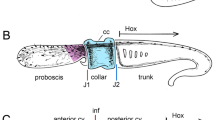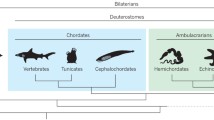Abstract
Since the identification of the Lower Cambrian Yunnanozoon as a chordate in 1995 (ref. 1), large numbers of complete specimens of soft-bodied chordates from the Lower Cambrian Maotianshan Shale in central Yunnan (southern China) have been recovered. Here we describe a recently discovered craniate-like chordate, Haikouella lanceolata, from 305 fossil specimens in Haikou near Kunming. This 530 million-year-old (Myr) fish-like animal resembles the contemporaneous Yunnanozoon from the Chengjiang fauna (about 35 km southeast of Haikou) in several anatomic features. But Haikouella also has several additional anatomic features: a heart, ventral and dorsal aorta, an anterior branchial arterial, gill filaments, a caudal projection, a neural cord with a relatively large brain, a head with possible lateral eyes, and a ventrally situated buccal cavity with short tentacles. These findings indicate that Haikouella probably represents a very early craniate-like chordate that lived near the beginning of the Cambrian period during the main burst of the Cambrian explosion. These findings will add to the debate on the evolutionary transition from invertebrate to vertebrate2.





Similar content being viewed by others
References
Chen,J. Y., Dzik,J., Edgecombe,G. D., Ramsköld,L. & Zhou,G.-Q. A possible Early Cambrian chordate. Nature 377, 720–722 (1995).
Holland,N. D. in International Symposium of the Origins of Animal Body Plans and their Fossil Records (eds Chen, J.-Y. et al.) 11 (Early Life Research Center, Jinning, 1999).
Hou,X.-G., Ramsköld,L. & Bergström,J. Composition and preservation of the Chengjiang Fauna–Lower Cambrian soft-bodied biota. Zool. Scripta 20, 395–411 (1991).
Chen,J.-Y., Zhou,G.-Q., Zhu,M.-Y. & Yeh,G.-Y. The Chenjiang Biota—A Unique Window of the Cambrian Explosion (National Museum of Natural Sciences Press, Taichung, 1996).
Chen,J.-Y. & Zhou,G.-Q. in the Cambrian Explosion and the Fossil Record (eds Chen, J.-Y., Cheng, Y.-N. & Van Iten, H.); Bull. Natl. Mus. Nat. Sci. 10, 11–105, (1997).
Aldridge,R. J. & Purnell,M. A. The conodont controversies. Trends 11, 463–466 (1996).
Chen,J.-Y. & Li,C.-W. in The Cambrian Explosion and the Fossil Record (eds Chen, J.-Y., Cheng, Y.-N. & Van Iten, H.); Bull. Natl. Mus. Nat. Sci. 10, 257–273, 1997).
Dohrn,A. Studien zur Urgeschte des Wirbelthierkoerpers. V. Zur Entstehung und Differenzierung der Viscceralbogen bei Petromyzon planeri. Mitt. Zool. Station Neapel 5, 152–161 (1884).
Dzik,J. Yunnanozoon and the ancestry of chordates. Acta Palaeontol. Pol. 40, 341–360 (1995).
Bliek,A. At the origin of chordates. Geobios 25, 101–113 (1992).
Shu,D.-G., Zhang,X.-L. & Chen,L. Reinterpretation of Yunnanozoon as the earliest known hemichordate. Nature 380, 428–429 (1996).
Young,J. Z. The Life of Vertebrates 3rd edn (Clarendon, Oxford, 1981).
Chen,J.-Y. in International Cambrian Explosion Symposium (eds Chen, J.-Y., Edgecombe, G. & Ramsköld, L.) 7–9 (Early Life Research Center, Nanjing, 1995).
Stokes,M. D. & Holland,N. D. The lancelet. Am. Sci. 86, 552–560 (1998).
Wada,H. & Satoh,N. Details of the evolutionary history from invertebrates to vertebrates, as deduced from the sequence of 18SrDNA. Proc. Natl Acad. Sci. USA 91, 383–490 (1994).
Lacalli,T. C., Holland,N. D. & West,J. E. Landmarks in the anterior central nervous system of amphioxus larvae. Phil. Trans. R. Soc. Lond. B 344, 165–185 (1994).
Holland,P. W. H., Holland,L. Z. & Holland,N. D. The molecular control of spatial patterning in amphioxus. J. Mar. Biol. Assoc. UK 74, 49–60 (1994).
Purnell,M. A., Aldridge,R. J., Donoghue,P. C. J. & Gabbott,S. E. Conodonts and the first vertebrates. Endeavour 19, 20–27 (1995).
Acknowledgements
We thank N. Holland, E. Davidson, and D. Walossek for discussions and comments, and F. Gao for technical assistance. This work was supported by National Department of Science and Technology, National Foundation of Natural Sciences, Jiangsu Provincial Committee of Science and Technology. The research of L.C.W. is supported by National Science Council.
Author information
Authors and Affiliations
Corresponding author
Rights and permissions
About this article
Cite this article
Chen, JY., Huang, DY. & Li, CW. An early Cambrian craniate-like chordate. Nature 402, 518–522 (1999). https://doi.org/10.1038/990080
Received:
Accepted:
Issue Date:
DOI: https://doi.org/10.1038/990080
- Springer Nature Limited
This article is cited by
-
Adipose fin development and its relation to the evolutionary origins of median fins
Scientific Reports (2019)
-
Re–Os geochronology of the Cambrian stage-2 and -3 boundary in Zhijin County, Guizhou Province, China
Acta Geochimica (2018)
-
Evolutionary history of the extant amphioxus lineage with shallow-branching diversification
Scientific Reports (2017)
-
Putative extremely high rate of proteome innovation in lancelets might be explained by high rate of gene prediction errors
Scientific Reports (2016)
-
Transcriptome analysis of different developmental stages of amphioxus reveals dynamic changes of distinct classes of genes during development
Scientific Reports (2016)





